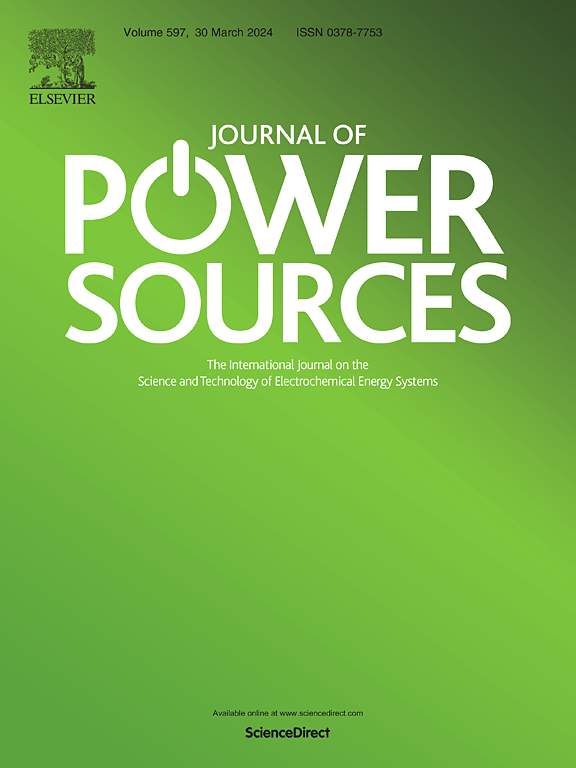环化聚丙烯腈基四唑介导聚乙二醇交联粘合剂用于高性能硅阳极的电化学性能增强
IF 7.9
2区 工程技术
Q1 CHEMISTRY, PHYSICAL
引用次数: 0
摘要
石墨是一种广泛使用的阳极材料,硅是石墨的一种很有前途的替代品,其容量比石墨高出十倍(4200 mAh g−1)。然而,它的低电导率,加上电极的固有电阻,使得充分利用其理论容量具有挑战性。此外,在充放电循环过程中,硅的反复体积膨胀会对电极的稳定性产生不利影响,这是硅阳极商业化的关键障碍。在本研究中,双叠氮化物-聚乙二醇(PEG)作为交联剂用于聚丙烯腈(PAN)。通过热诱导环化和点击反应生成三维网络结构,得到环化pan基peg -交联x-cPAN-PEG。与环化PAN (cPAN)粘合剂相比,该粘合剂具有较高的电子和离子导电性,并增强了对Si的附着力。x-cPAN-PEG的交联结构也导致了优异的力学性能。采用350 nm Si和x-cPAN-PEG的电极具有88%的初始库仑效率(ICE),初始容量为4276.9 mAh g−1。值得注意的是,经过100次循环后,容量保持率为70%。此外,使用2 μm Si和x- cppan - peg的Si/C复合电极在350次循环后的容量保持率高达64.6%,与商用粘合剂CMC/SBR相比,证实了优越的电池性能。本文章由计算机程序翻译,如有差异,请以英文原文为准。

Enhanced electrochemical performance of cyclized PAN-based tetrazole-mediated PEG-crosslinked binder for high-performance silicon anodes
Si, a promising alternative to graphite, a widely used anode material, exhibits a capacity over tenfold higher (4200 mAh g−1) than that of graphite. However, its low conductivity, combined with the intrinsic resistance of the electrode, makes it challenging to fully utilize its theoretical capacity. Moreover, the repeated volume expansion of Si during charge and discharge cycles adversely affects electrode stability, a key barrier to commercializing Si anodes. In this study, bis(azide)-polyethylene glycol (PEG) is used as a crosslinking agent in polyacrylonitrile (PAN). A 3D network structure is generated via thermally induced cyclization and click reactions, yielding the cyclized PAN-based PEG-crosslinked x-cPAN-PEG. The binder exhibits high electronic and ionic conductivity and enhances adhesion to Si compared with the cyclized PAN (cPAN) binder. The crosslinked structure of x-cPAN-PEG also leads to excellent mechanical properties. The electrodes using 350-nm Si and x-cPAN-PEG demonstrates a high initial coulombic efficiency (ICE) of 88 %, with an initial capacity of 4276.9 mAh g−1. Notably, the capacity retention is 70 % after 100 cycles. Furthermore, Si/C composite electrodes using 2-μm Si and x-cPAN-PEG shows much higher capacity retention of 64.6 % after 350 cycles, confirming a superior cell performance compared to CMC/SBR, a commercial binder.
求助全文
通过发布文献求助,成功后即可免费获取论文全文。
去求助
来源期刊

Journal of Power Sources
工程技术-电化学
CiteScore
16.40
自引率
6.50%
发文量
1249
审稿时长
36 days
期刊介绍:
The Journal of Power Sources is a publication catering to researchers and technologists interested in various aspects of the science, technology, and applications of electrochemical power sources. It covers original research and reviews on primary and secondary batteries, fuel cells, supercapacitors, and photo-electrochemical cells.
Topics considered include the research, development and applications of nanomaterials and novel componentry for these devices. Examples of applications of these electrochemical power sources include:
• Portable electronics
• Electric and Hybrid Electric Vehicles
• Uninterruptible Power Supply (UPS) systems
• Storage of renewable energy
• Satellites and deep space probes
• Boats and ships, drones and aircrafts
• Wearable energy storage systems
 求助内容:
求助内容: 应助结果提醒方式:
应助结果提醒方式:


